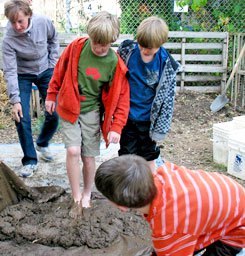How Does Your School Garden Grow?
On a crisp fall morning, I watched students at Lewis Elementary School, in Portland, Oregon, roll up their pant legs and wade barefoot into piles of sand, clay, straw, and water.

There were smiles galore and a few squeals as kids squished the earthy mixture called cob between their toes. It was messy, sure, but also meaningful. Using an ancient method called natural building, students were constructing a brand-new bench for their ever-expanding school garden.
During the months ahead, students can look forward to gathering on their high-backed, curving bench for science investigations, art projects, and story writing. Teachers will share the space, too, for al fresco lunches and quiet conversations. And when parent volunteers meet on the bench, they can reminisce about the chilly day when they helped kids turn mud into something lasting.
Project by project, that's how the Lewis Outdoor Education Center grows. The school offers a good example of how to nurture a school garden by engaging parent volunteers and community partners, while also building a sense of stewardship among students.
Nationwide, school gardens are sprouting in all kinds of settings. More than 1,200 schools have joined the Garden in Every School Registry, maintained by the National Gardening Association. I've visited school gardens of all shapes and sizes, consisting of everything from a few planter boxes to elaborate edible landscapes. They all need careful tending in order to blossom. Here are a few strategies worth sharing:
Grow Slowly
Principal Tim Lauer, now in his seventh year at Lewis, has watched his outdoor learning space expand to include raised garden beds, greenhouses, composting bins, and even an outdoor classroom complete with eco-roof and barrels for harvesting rainwater. Located right outside a classroom wing, the garden is used throughout the day for serious academic work as well as simple relaxation.
"We didn't start with a grand plan," the principal admits. "We've been receptive to ideas and welcome people who want to join us." The outdoor classroom, for instance, was built by a local volunteer group called City Repair.
Engage Volunteers
Engaging with volunteers takes ongoing effort. Lewis has a staff member named Julia Hamlin who serves as the school's community agent, coordinating volunteer outreach and scheduling. The 60 volunteers on her roster contribute to the outdoor learning space in a variety of ways, from grant writing to light construction to summer watering teams. What motivates them to give their time?
"We're part of this school, too," said Julie LaRoche, a parent of two Lewis students who was helping students build the cob bench. "I feel like it's my community as much as it is my kids'."
The school garden doesn't produce enough vegetables to feed the whole school -- not yet, anyway. "That's down the road a bit," Lauer admits. But Hamlin organizes occasional dinners, featuring produce grown on the premises, to engage the larger community.
Support Teachers
Hamlin also works with teachers who want to integrate garden activities into the curriculum. As part of a weather unit, for instance, one class made wind chimes out of recycled metal cans and old utensils. Another class, studying U.S. colonial history, grew an assortment of red, white, and blue potatoes. Still others have used the greenhouse to germinate seeds and study the life cycle of plants.
Hamlin draws on her background in landscape design and horticulture to help plan environmental learning activities that meet teachers' instructional goals. That support makes it more likely that teachers will use the garden as a learning space.
Develop Healthy Habits
The school's Earth-friendly ethic carries over to the lunchroom, too: Parent volunteers arrive daily to wash reusable trays and silverware, reducing the school's trash bill by eliminating disposable foam trays and plastic utensils. Third graders take charge of composting scraps from the cafeteria salad bar, giving them real-world lessons in both science and service.
Make It Last
Growing such a successful school garden program doesn't happen in one season. And it doesn't last without sustained effort. Several years ago, I heard about a school that was growing its own grove of miniature apple trees. Students maintained a weather station, conducted horticultural experiments, and even sold produce in an entrepreneurship project.
The apple orchard seemed like the school's pride -- but it was actually one teacher's pet project. When he retired, there was no one willing to keep it going. The little orchard was bulldozed. It's a cautionary tale for school garden advocates.
Fortunately, there are a growing number of resources for communities that want to get their school gardens off to a healthy start. Here are a few:
- The Edible Schoolyard, a pioneer in school gardening, developed the thriving outdoor learning space at Martin Luther King Jr. Middle School, in Berkeley, California. (Learn more in the Edutopia.org article "Middle School Students Grow Their Own Lunch" and the accompanying video, The Edible Schoolyard Yields Seed-to-Table Learning.)
- KidsGardening, a project of the nonprofit National Gardening Association, coordinates the Adopt a School Garden program.
- The California School Garden Network offers online information about how to set up a school garden.
- School Garden Wizard offers garden-planning tools and showcases a gallery of school-garden photos.